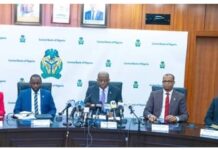
There is an ongoing debate about the stability currently being experienced in the power sector. While some argue that the rains are responsible for the temporary relief, there are those who hold the view that the efforts of the Minister of Power, Works and Housing, Babatunde Raji Fashola, might have begun to yield results, writes Olawale Olaleye
Off the turf of real politics, the debate about power is one in which no Nigerian can be stifled, because of the many ways power seems to affect him. Power, to him, is everything. Take away power and life becomes null and void and without form. Perhaps, it was the reason light was God’s first invention at the formation of the earth from its crudest form.
Unfortunately, the history of power failure in Nigeria is synonymous with her creation many years ago. The nation’s story about power has never been anything elating, even when Nigeria could be said to have had it good in other sectors – nothing positive has been consciously recorded against the power sector. With ludicrous generation capacity, Nigeria has remained the joke of the continent, struggling with paltry megawatts that could merely pass as the byproducts of optimal power generation in other parts of the world.
It is no surprise too that power, for many years, has become a campaign issue in the country and the present ruling party, the All Progressives Congress (APC) made a good capital from it during the 2015 elections. Besides, the choice of the man in charge of power, Mr. Babatunde Fashola, a former governor of Lagos State, also gave the hope that things might change for the better in that sector, if Fashola’s record as governor is put forward for debate.
As a governor, whose tenure was generally believed to have altered the face of governance and embraced an entirely cosmopolitan approach to delivering on election promises, Fashola, on the contrary, has had a rather rough and tough start as minister. It was as a result of such teething challenges that some people in their compulsive irritant nature christened him the minister of darkness.
But the Mechanic as Professor Wole Soyinka, Nigeria’s Nobel Laureate is wont to call him, was neither disturbed nor distracted. Focused, determined and committed to the road map he outlined for the power sector, Fashola’s clinically thorough efforts at fixing the power menace seem to be paying off gradually.
From the initially celebrated body language of the administration to a relapse to near total darkness, Fashola’s out-of-the-ordinary initiative in ensuring stable power supply is gradually shifting the debate in the all-important sector of the economy.
Yet, the debate is instructive, indeed, a good one. There are those who reckon the current stability in electricity supply is not new at this time of the year, when the rains are in full cycle. They contend that with increased water level, the dams across the country are usually in full swing and therefore, nothing extraordinary might have been added to support the current stability in power supply.
But another school finds the argument defective. While this school agrees that the water level as a result of the rains might have helped to boost and sustain the current stability through hydro dams, Fashola, they posit, has taken the initiative beyond mere reliance on what is not within his control, if capacity and the application of knowledge were to change the slant of debate.
For instance, the total power generated as at February this year was 5,074 megawatts and 80 per cent of that was from gas, which was about 4,000 megawatts. Not long after, the nation lost 3,000 of the 5,074 megawatts to vandalism and the insensate attacks on oil installations in the Niger Delta region of the country, leaving the entire nation to deal with 2,074 megawatts. That naturally affected power supply for some time.
Today, however, the current capacity is averagely around 3,500, even when what was responsible (vandalism) for the initial loss of 3,000 megawatts has not been sufficiently addressed. The question, therefore, is: how did the nation get the additional megawatts that are currently sustaining supply?
First is hydro. Since water is the fuel for hydro dam – the more water, the more energy – and about 300 megawatts is being sourced here alone. In other words, the debate about the rains assisting supply is valid and true to it. But that does not automatically translate to electricity if the power plants – the electrical parts of the project – are not maintained and put in their best form.
Recall that Fashola, on assumption of office had commissioned the Jebba plant. That was part of the maintenance initiative embraced to enhance efficient support for supply. The same maintenance approach was applied to the turbine in Shiroro and the dam in Kainji. What this means is that they have been firing more turbines, meaning more power is being realised from hydro as a result.
From the Lagos axis alone, government is also realising about 40 megawatts, which helps to up the capacity of what is being used nationally. And since certain areas naturally need more power than the others, even as some are wired to need power at a particular time of the day, the judicious application of the supply further assists in achieving a degree of balance.
Evacuating condensing in some gas production lines is another move known to have assisted greatly in realising stability, take for instance, the gas at Itorogwu, which has helped to increase supply at the eastern line.
Suffice it to note that while the 3,000 megawatts earlier lost to vandalism has not been restored yet, a balance has been gained somewhat from other sources like in Okada, Edo State, Igbogbo in Ikorodu and Alagbon in Ikoyi, both in Lagos as well as Maiduguri, Borno State. Whilst it is true that the rains have helped significantly in raising supply and stability, it should not also be lost on the debate that the maintenance of the electrical aspects is germane to the positive results.
There is also the plan by government to support an initiative in Kainji and Jebba for what is known as partial risk guarantee to secure funding for 300 megawatts from solar that will be connected to the grid. This forms part of the power diversification initiative of the ministry to maintaining and sustaining the current level of success while working harder to pushing it further up. And since no one source of power is sufficient, the diversification model becomes imperative.
Look at it this way, one, hydro is seasonal because it comes with the rain, and so also is the solar source which is controlled by the rising and setting of the sun. On the other hand, coal and gas too have their limitations in terms of environmental damage.
Thus, while government is not oblivious of the challenges of each of these sources, the diversification initiative is complementary of each other and which will further test the sustainability of this model at a time other sources of power appear to be at their lowest ebb.
Taken together, Fashola’s headship intends to achieve his goal of a promising power sector through a combination of energy blend as well as preservation policy, which he glibly refers to as power diversification initiative.
Central to this is the recently approved different solar projects – about 14 of them – to generate a combined capacity of 1,286 megawatts, most likely the biggest solar projects the country has ever undertaken. And if achieved, it would help deliver in a matter of months, stable power supply. The gap that has been over time created in the power supply through the already weak infrastructure, Fashola is bridging by repairing and rehabilitating the existing infrastructure.
Another laudable initiative of the minister is the consideration being conceded to the possibility of decentralising the grid while still keeping them interconnected.
At the fifth monthly Power Sector Operators meeting hosted by the minister at Shiroro Hydro Power Plant in Niger State, the Transmission Company of Nigeria (TCN) provided progress update on 16 critical projects identified by distribution and generation companies.
These are the repairs of the Owerri/Ahoda/Yenagoa line, which now connects the newly commissioned Gbarain plant to the grid. The completion of repairs to transmission projects in Ajah, Akoka, Afam and Kainji was also announced by TCN at the meeting. This elucidates focus, determination and commitment.
In addition to the recent overhauling of the Jebba Hydro power plant, which was Fashola’s first assignment on assumption of office were the repairs of the Egbin power plant in Ikorodu, which hitherto had only two functional turbines in 2013 but now has all of its six turbines working. Repair works are also ongoing at the Forcados pipeline damaged by vandals and this is expected to be completed soon to allow gas to be supplied to thermal, power stations and result in an increased power on the grid.
The Azura Independent Power Project in Edo State is also receiving great attention and is expected to deliver 450 megawatts upon completion sometime in 2018. Supporting this is the Zungeru Power plant dispute in Niger State, which was held up in court for several years but has not been resolved by the minister. When completed, the power plant is estimated to deliver not less than 700 megawatts to the national grid.
There is also a new inter-agency collaboration aimed at achieving optimal cooperation to assist power producers, investors and all stakeholders in the siting of solar and hydro projects in the North, coal in the North Central, and South-east as well as gas plants in the South-west and South-south.
This is even the more promising as the Ministry of Petroleum Resources has promised to provide gas to encourage investors in the sector while its water resources counterpart has agreed, in collective interest, to provide access to Dams and River basins for hydropower use. In the same vein, the Ministry of Solid Minerals is said to be providing coal data to assist the revival of some of the coal-to-power initiatives.
With a well-articulated road map for Change in the power sector geared towards addressing the nation’s electricity challenge, there is certainly no mistaking the fact that these clearly lined up efforts of Fashola will eventually lead to stable and constant power supply in no time.
Quote
The debate is instructive, indeed, a good one. There are those who reckon the current stability in electricity supply is not new at this time of the year, when the rains are in full cycle…Another school finds the argument defective. While this school agrees that the water level as a result of the rains might have helped to boost and sustain the current stability through hydro dams, Fashola, they posit, has taken the initiative beyond mere reliance on what is not within his control, if capacity and the application of knowledge were to change the slant of debate





